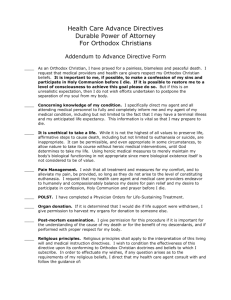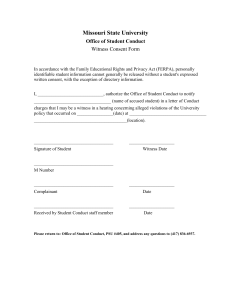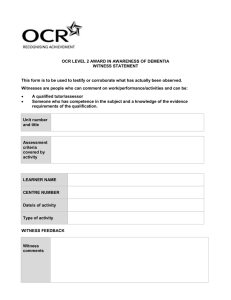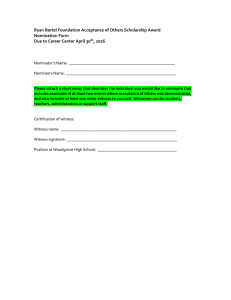Exceptions to the rule against hearsay
advertisement
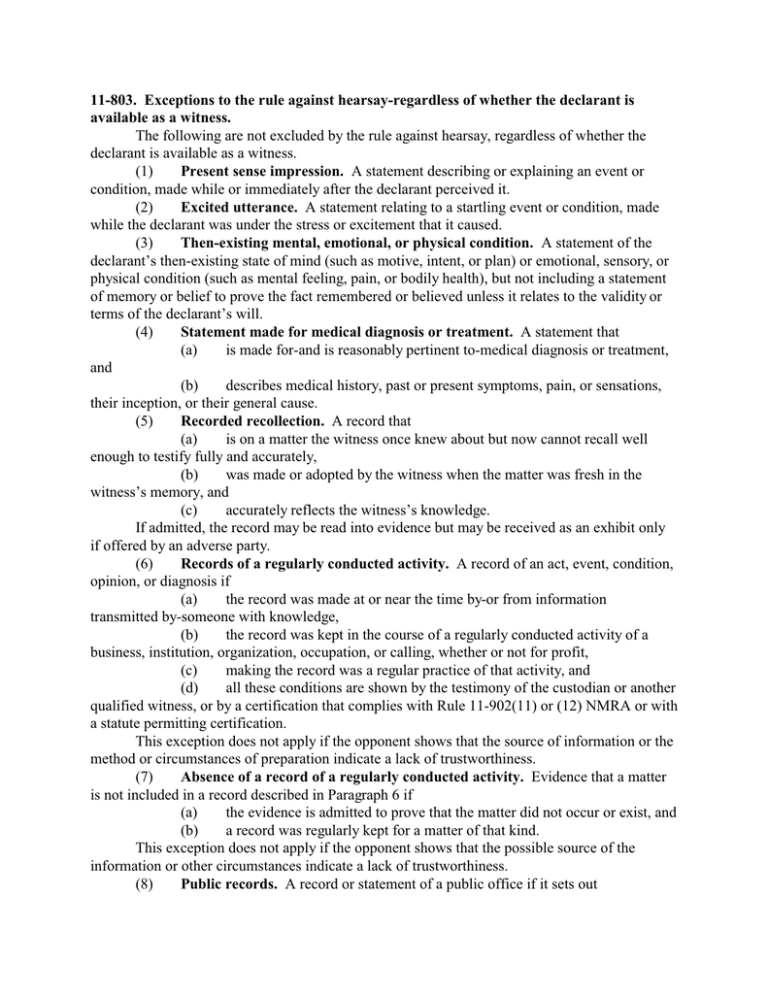
11-803. Exceptions to the rule against hearsay-regardless of whether the declarant is available as a witness. The following are not excluded by the rule against hearsay, regardless of whether the declarant is available as a witness. (1) Present sense impression. A statement describing or explaining an event or condition, made while or immediately after the declarant perceived it. (2) Excited utterance. A statement relating to a startling event or condition, made while the declarant was under the stress or excitement that it caused. (3) Then-existing mental, emotional, or physical condition. A statement of the declarant’s then-existing state of mind (such as motive, intent, or plan) or emotional, sensory, or physical condition (such as mental feeling, pain, or bodily health), but not including a statement of memory or belief to prove the fact remembered or believed unless it relates to the validity or terms of the declarant’s will. (4) Statement made for medical diagnosis or treatment. A statement that (a) is made for-and is reasonably pertinent to-medical diagnosis or treatment, and (b) describes medical history, past or present symptoms, pain, or sensations, their inception, or their general cause. (5) Recorded recollection. A record that (a) is on a matter the witness once knew about but now cannot recall well enough to testify fully and accurately, (b) was made or adopted by the witness when the matter was fresh in the witness’s memory, and (c) accurately reflects the witness’s knowledge. If admitted, the record may be read into evidence but may be received as an exhibit only if offered by an adverse party. (6) Records of a regularly conducted activity. A record of an act, event, condition, opinion, or diagnosis if (a) the record was made at or near the time by-or from information transmitted by-someone with knowledge, (b) the record was kept in the course of a regularly conducted activity of a business, institution, organization, occupation, or calling, whether or not for profit, (c) making the record was a regular practice of that activity, and (d) all these conditions are shown by the testimony of the custodian or another qualified witness, or by a certification that complies with Rule 11-902(11) or (12) NMRA or with a statute permitting certification. This exception does not apply if the opponent shows that the source of information or the method or circumstances of preparation indicate a lack of trustworthiness. (7) Absence of a record of a regularly conducted activity. Evidence that a matter is not included in a record described in Paragraph 6 if (a) the evidence is admitted to prove that the matter did not occur or exist, and (b) a record was regularly kept for a matter of that kind. This exception does not apply if the opponent shows that the possible source of the information or other circumstances indicate a lack of trustworthiness. (8) Public records. A record or statement of a public office if it sets out (a) the office’s activities, (b) a matter observed while under a legal duty to report, but not including, in a criminal case, a matter observed by law-enforcement personnel, or (c) in a civil case or against the government in a criminal case, factual findings from a legally authorized investigation. This exception does not apply if the opponent shows that the source of information or other circumstances indicate a lack of trustworthiness. (9) Public records of vital statistics. Records or data compilations of births, deaths, or marriages, if reported to a public office in accordance with a legal duty. (10) Absence of a public record. Testimony-or a certification under Rule 11-902 NMRA-that a diligent search failed to disclose a public record or statement if the testimony or certification is admitted to prove that (a) the record or statement does not exist, or (b) a matter did not occur or exist, even though a public office regularly kept a record or statement for a matter of that kind. (11) Records of religious organizations concerning personal or family history. A statement of birth, legitimacy, ancestry, marriage, divorce, death, relationship by blood or marriage, or similar facts of personal or family history, contained in a regularly kept record of a religious organization. (12) Certificates of marriage, baptism, and similar ceremonies. A statement of fact contained in a certificate (a) made by a person who is authorized by a religious organization or by law to perform the act certified, (b) attesting that the person performed a marriage or similar ceremony or administered a sacrament, and (c) purporting to have been issued at the time of the act or within a reasonable time after it. (13) Family records. A statement of fact about personal or family history contained in a family record, such as a Bible, genealogy, chart, engraving on a ring, inscription on a portrait, or engraving on an urn or burial marker. (14) Records of documents that affect an interest in property. The record of a document that purports to establish or affect an interest in property if (a) the record is admitted to prove the content of the original recorded document, along with its signing and its delivery by each person who purports to have signed it, (b) the record is kept in a public office, and (c) a statute authorizes recording documents of that kind in that office. (15) Statements in documents that affect an interest in property. A statement contained in a document that purports to establish or affect an interest in property if the matter stated was relevant to the document’s purpose-unless later dealings with the property are inconsistent with the truth of the statement or the purport of the document. (16) Statements in ancient documents. A statement in a document that is at least twenty (20) years old and whose authenticity is established. (17) Market reports and similar commercial publications. Market quotations, lists, directories, or other compilations that are generally relied on by the public or by persons in particular occupations. (18) Statements in learned treatises, periodicals, or pamphlets. A statement contained in a treatise, periodical, or pamphlet, if (a) the statement is called to the attention of an expert witness on cross-examination or relied on by the expert on direct examination, and (b) the publication is established as a reliable authority by the expert’s admission or testimony, by another expert’s testimony, or by judicial notice. If admitted, the statement may be read into evidence but not received as an exhibit. (19) Reputation concerning personal or family history. A reputation among a person’s family by blood, adoption, or marriage-or among a person’s associates or in the community-concerning the person’s birth, adoption, legitimacy, ancestry, marriage, divorce, death, relationship by blood, adoption, or marriage, or similar facts of personal or family history. (20) Reputation concerning boundaries or general history. A reputation in a community-arising before the controversy-concerning boundaries of land in the community or customs that affect the land, or concerning general historical events important to that community, state, or nation. (21) Reputation concerning character. A reputation among a person’s associates or in the community concerning the person’s character. (22) Judgment of a previous conviction. Evidence of a final judgment of conviction if (a) the judgment was entered after a trial or guilty plea, but not a nolo contendere plea, (b) the judgment was for a crime punishable by death or by imprisonment for more than a year, (c) the evidence is admitted to prove any fact essential to the judgment, and (d) when offered by the prosecutor in a criminal case for a purpose other than impeachment, the judgment was against the defendant. The pendency of an appeal may be shown but does not affect admissibility. (23) Judgments involving personal, family, or general history, or a boundary. A judgment that is admitted to prove a matter of personal, family, or general history, or boundaries, if the matter (a) was essential to the judgment, and (b) could be proved by evidence of reputation. [Adopted effective July 1, 1973; as amended, effective April 1, 1976; December 1, 1993; as amended by Supreme Court Order 07-8300-23, effective November 1, 2007; by Supreme Court Order No. 12-8300-015, effective for all cases pending or filed on or after June 16, 2012; as amended by Supreme Court Order No. 15-8300-012, effective for all cases filed or pending on or after December 31, 2015.] Committee commentary. — The language of Rule 11-803 NMRA was amended in 2012 to be consistent with the restyling of the Federal Rules of Evidence, effective December 1, 2011, to make them more easily understood and to make style and terminology consistent throughout the rules. These changes are intended to be stylistic only. There is no intent to change any result in any ruling on admissibility. The internal numbering of the rule was also changed to conform to the numbering of the federal rule. In 2007, the committee added language to former Paragraph F, now renumbered as Paragraph 6, taken from a similar change made in 2000 to federal Rule 803(6) of the Federal Rules of Evidence. The amendment provides that the foundation requirements of Rule 803(6) can be satisfied under certain circumstances without the expense and inconvenience of producing time-consuming but non-substantive foundation witnesses. Corresponding changes have been made to Rule 11-902 NMRA. Eliminating the identical “catch-all” exception in Paragraph X of this rule and Subparagraph (5) of Paragraph B of Rule 11-804 NMRA and combining them in new rule 11-807 NMRA, with no intended change in meaning, tracks the 2000 amendments to the corresponding federal rules. [As amended by Supreme Court Order No. 12-8300-015, effective for all cases pending or filed on or after June 16, 2012.]
